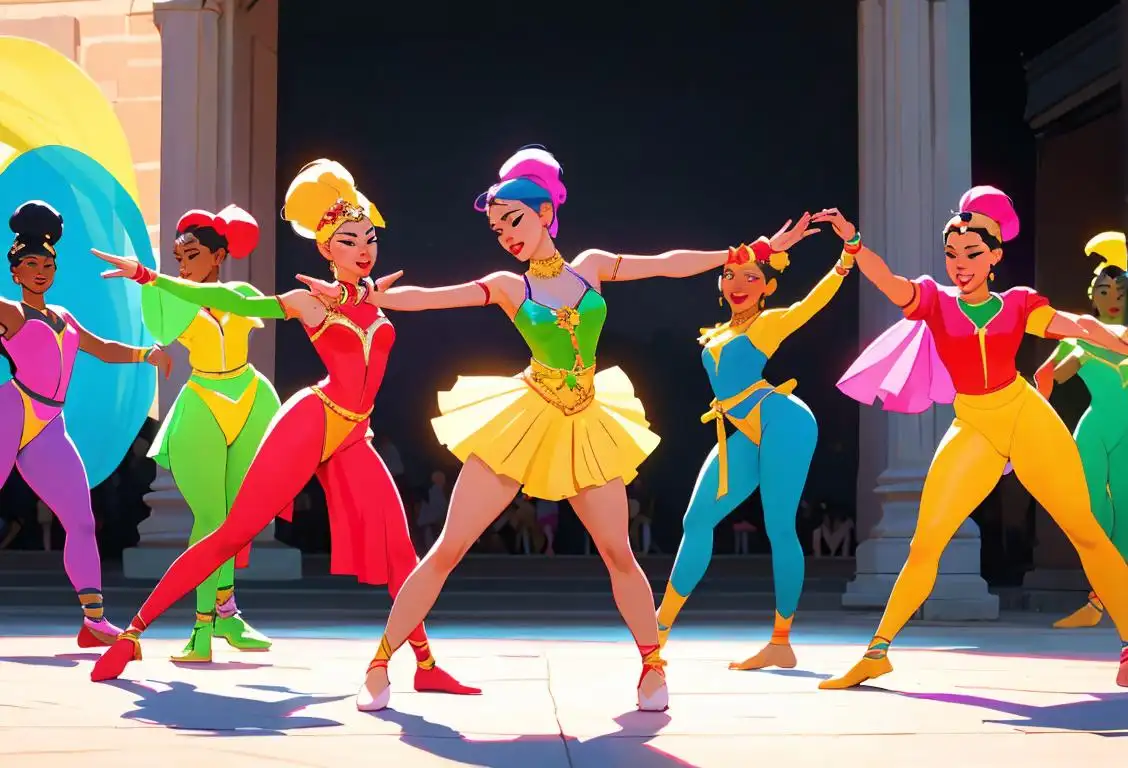National Sport Heritage Day

Welcome to National Sport Heritage Day! Strap on your sneakers and get ready to dive into the fascinating world of sports history. This day is all about celebrating the rich heritage and cultural significance of various sports. Whether you're a die-hard fan or just enjoy the occasional game of catch, National Sport Heritage Day is the perfect occasion to explore the roots of your favorite sports.
When is Sport Heritage Day?
It's national sport heritage day on the 30th September.
The Origins of National Sport Heritage Day
It's time for a trip down memory lane! National Sport Heritage Day originated from the growing interest in preserving and promoting the historical importance of sports. Dating back to ancient times, sports have played a vital role in our culture, shaping communities, inspiring athletes, and fostering a sense of camaraderie.
With the rise of the internet, it became easier than ever to share and document sports-related information. From historic sporting events to legendary athletes, the digital realm has become a treasure trove of sports history. National Sport Heritage Day serves as a reminder of the importance of preserving this heritage for future generations.
Celebrating National Sport Heritage Day
There's no shortage of ways to celebrate National Sport Heritage Day. Get together with your friends and family for a friendly game of your favorite sport. Take a trip to your local sports museum or exhibition to delve into the history of your beloved game. You can also organize trivia nights or watch classic sports documentaries to learn more about the legends who paved the way.
Sports heritage is all about appreciating the traditions, skills, and stories that make every sporting encounter special. So, grab your popcorn, put on your lucky jersey, and let's dive into the world of sports history!
History behind the term 'Sport Heritage'
1896
Inception of the modern Olympic Games
The term 'sport heritage' traces its roots back to the year 1896 when the modern Olympic Games were first held in Athens, Greece. This marked a significant moment in the history of sports, as it brought together athletes from different nations to compete in a variety of disciplines. The Olympic Games became a symbol of unity, fair competition, and the preservation of sporting traditions.
1860
Inception of organized sports clubs
During the mid-19th century, various sports clubs started to emerge, creating a foundation for what would eventually be called sport heritage. The formation of these clubs allowed for organized competitions and the development of standardized rules for various sports.
1896
Introduction of the modern Olympic Games
The term 'sport heritage' traces its roots back to the revival of the Olympic Games in Athens, Greece in 1896. The International Olympic Committee (IOC) brought together athletes from different nations to compete in various sports. This marked the beginning of a movement that would preserve and celebrate sports as a cultural heritage.
19th century
Emergence of organized sports
The term 'sport heritage' traces its origins back to the 19th century when organized sports began to gain popularity. This period witnessed the establishment of various sports clubs and organizations around the world, giving rise to a collective interest in preserving and celebrating sports history.
1964
Emergence of the Term
The term 'sport heritage' first emerged in 1964 to describe the cultural and historical significance of sports. It encompasses the traditions, artifacts, stories, and intangible aspects associated with sports events and personalities. Initially, the term was primarily used within academic circles to explore the relationship between sports and cultural heritage.
1960
The Birth of Sport Heritage
In the year 1960, the term 'sport heritage' was first coined to describe the collective history and cultural significance of sports. It emerged as a way to recognize the value of sports in society beyond their immediate competitive aspect. The term aimed to emphasize the heritage of sports as an integral part of a nation's culture and identity.
1828
Origins of Sport Heritage
The term 'sport heritage' traces its roots back to the early 19th century. In 1828, the word 'sport' was first used in Old English to refer to any form of physical activity or game that involved skill or competition. At this time, 'sport' encompassed a variety of activities, including hunting, fishing, and horseback riding, among others.
1977
Introduction of the term
The term 'sport heritage' was first introduced in the field of heritage studies in 1977. It aimed to highlight the cultural significance and historical value of sports. Sports have long been an integral part of human civilization, and the term 'sport heritage' recognized the need to preserve and celebrate this aspect of our culture.
1980
The Birth of Sport Heritage
The term 'sport heritage' was first coined in the year 1980. It emerged as a way to describe the cultural, social, and historical significance of sports in various societies. The concept of sport heritage recognizes the importance of preserving and promoting sporting traditions, artifacts, and practices as a means of understanding and appreciating our collective past.
1983
Emergence of the Term
The term 'sport heritage' was first coined in 1983 to describe the cultural significance and preservation of sporting traditions and artifacts. It emerged as a response to the growing interest in the history and heritage of sports and their impact on society.
1972
Establishment of the International Sport Heritage Association
In 1972, the International Sport Heritage Association (ISHA) was founded to promote the study and preservation of sport heritage. ISHA aimed to explore the cultural, social, and historical significance of sports and their impact on society. This was a pivotal moment that brought academic, cultural, and sporting communities together to recognize the value of preserving and celebrating sport heritage.
1860s
Development of Modern Sports
During the 1860s, the concept of 'sport' began to evolve and become more organized. The introduction of modern sports, like football, cricket, and tennis, brought about a new era in the world of physical activities. These sports gained popularity and started to shape the cultural landscape of many countries, forming the foundation of the sport heritage we recognize today.
1894
First international sports organization
In 1894, the International Olympic Committee (IOC) was established, marking the first international sports organization. The IOC aimed to promote and preserve the tradition of athletic competitions, giving birth to the global aspect of sport heritage. The IOC played a vital role in organizing the modern Olympic Games, which further solidified the concept of sport heritage.
Late 19th to early 20th century
Development of sports museums
During the late 19th and early 20th centuries, the concept of sports museums started to gain traction. Curators and enthusiasts recognized the importance of preserving artifacts, memorabilia, and historical records related to sports. This led to the establishment of dedicated sports museums aimed at showcasing and safeguarding the heritage of various sports.
1960
Emergence of sport heritage organizations
In the 1960s, various organizations started recognizing the value of preserving sporting history. The formation of institutions like the Sports Heritage Trust and the World Olympians Association emphasized the importance of safeguarding and promoting the heritage associated with sports. These organizations began documenting and archiving historical artifacts, stories, and events related to sports.
1994
Recognition by International Organizations
In 1994, the importance of sport heritage was officially recognized with the establishment of the International Sport Heritage Association (ISHA). This organization aimed to promote the study and preservation of sport heritage globally. It brought together academics, sports professionals, and enthusiasts who were passionate about documenting and safeguarding the history and traditions of various sports.
1995
The Emergence of Sport Heritage Organizations
In the year 1995, sport heritage gained increased recognition, leading to the establishment of dedicated organizations and institutions focused on its preservation. These organizations began collecting, archiving, and showcasing sporting artifacts, documents, and memorabilia. They also initiated efforts to raise awareness about the historical significance of sports and their cultural impact. The emergence of these organizations played a vital role in promoting the concept of sport heritage globally.
1980
Recognition by International Organizations
In the 1980s, international organizations such as UNESCO and the International Council on Monuments and Sites (ICOMOS) began recognizing the importance of sport heritage. These organizations acknowledged that sports, especially those with long-standing traditions, carry a significant cultural value and contribute to the preservation of national and global heritage.
1978
The UNESCO Recommendation
In 1978, the United Nations Educational, Scientific and Cultural Organization (UNESCO) recognized the importance of sport heritage by issuing a recommendation on the safeguarding and promotion of traditional sports and games. This recommendation brought international attention to the preservation and promotion of sports as an essential element of cultural heritage. It highlighted the need to protect traditional sports from the threat of extinction and encouraged their inclusion in educational programs.
1980
Recognition by UNESCO
In 1980, UNESCO (United Nations Educational, Scientific and Cultural Organization) officially recognized the importance of sport heritage. They acknowledged the role of sports in promoting social cohesion, cultural diversity, and sustainable development. This recognition helped elevate the status of 'sport heritage' as a valuable field of study and preservation.
1995
Recognition of sport heritage by UNESCO
In 1995, the concept of sport heritage gained international recognition when UNESCO (United Nations Educational, Scientific and Cultural Organization) officially acknowledged its importance. UNESCO's recognition further affirmed the significance of sport heritage in preserving and promoting cultural diversity, intercultural dialogue, and the values embedded in sports.
1994
International Sport Heritage Council
In 1994, the International Sport Heritage Council (ISHC) was established as a non-profit organization dedicated to the preservation, promotion, and research of sport heritage. The ISHC aimed to facilitate collaboration among individuals and organizations interested in sport heritage worldwide. Through conferences, publications, and research projects, the ISHC played a vital role in advancing the understanding and appreciation of sport heritage.
1993
Sport Heritage as a Field of Study
The academic study of sport heritage gained momentum in the 1990s. Scholars from various disciplines, including anthropology, sociology, history, and cultural studies, started delving into the cultural, social, and economic dimensions of sports and their historical remnants. It became an interdisciplinary field of study that aimed to uncover and analyze the cultural impact of sports.
1996
Inclusion in academic discourse
During the late 20th century, the term 'sport heritage' gained traction in academic circles. Scholars and researchers began exploring the intersection of sports and heritage, examining the ways in which sports activities, venues, and traditions contribute to our collective memory and identity. This increased scholarly attention propelled the field of sport heritage into a more prominent position.
2008
UNESCO's Recognition of Intangible Cultural Heritage of Sport
In 2008, the United Nations Educational, Scientific and Cultural Organization (UNESCO) acknowledged the importance of sport heritage by including the 'Intangible Cultural Heritage of Sport' on its representative list. This significant recognition highlighted the value of sports as a living heritage that encompasses not only tangible artifacts but also customs, rituals, knowledge, and social practices associated with various sports.
1983
Establishment of the International Sports Heritage Association
The International Sports Heritage Association (ISHA) was founded in 1983 with the aim of uniting individuals and organizations dedicated to preserving, studying, and promoting sport heritage. ISHA facilitates the exchange of knowledge and best practices among its members, contributing to the global understanding and appreciation of sport heritage.
2003
Sport Heritage Tourism
By the early 2000s, the concept of sport heritage tourism started to gain momentum. People began to travel to iconic sports venues, museums, and historic sites to experience the rich sporting heritage of different regions. This trend led to the development of dedicated sports heritage tourism programs and initiatives, which aimed to cater to the interests of sports enthusiasts and history buffs alike.
1924
Inclusion of sport heritage in Olympic Charter
The recognition of sport heritage as a crucial component of the Olympic Games came in 1924, when it was officially included in the Olympic Charter. This recognition emphasized the importance of history, culture, and tradition within the world of sports, solidifying sport heritage as a concept embraced by the international sporting community.
20th Century
Recognition of Sport as Heritage
As the 20th century rolled around, the significance of sport in society became increasingly apparent. Sports began to be recognized not only as forms of recreation and entertainment but also as an inherent part of cultural heritage. They became woven into the fabric of communities, representing shared traditions, values, and identities. This recognition led to the emergence of 'sport heritage' as a concept that encompassed the cultural and historical aspects of various sports.
1970s
Recognition of intangible sport heritage
In the 1970s, there was a shift in understanding sport heritage beyond physical objects. The intangible aspects of sports, such as traditions, rituals, and oral histories, began to be acknowledged as significant components of sport heritage. This broader view recognized that the cultural significance of sports extends beyond material artifacts alone.
2016
International Day of Sport for Development and Peace
The year 2016 marked the establishment of the International Day of Sport for Development and Peace by the United Nations. This day, celebrated annually on April 6th, aims to promote sport as a powerful tool for social progress, emphasizing its ability to foster inclusion, gender equality, and peace. Through the celebration of this day, sport heritage gained further recognition for its role in creating positive social change.
2005
Recognition by ICOMOS
In the year 2005, the International Council on Monuments and Sites (ICOMOS), a global organization focused on heritage conservation, formally recognized sport heritage as a significant cultural practice and heritage type. This recognition solidified the standing of sport heritage in the field of heritage conservation and led to increased efforts to preserve and interpret sporting sites, facilities, and artifacts.
2003
Emergence of sport heritage tourism
In 2003, sport heritage tourism emerged as a distinct sector within the broader tourism industry. This form of tourism involves visiting sports-related sites, museums, and events to experience and learn about sport heritage up close. The popularity of sport heritage tourism has grown steadily over the years, attracting sports enthusiasts, history buffs, and cultural explorers from around the world.
1980s
International focus on sport heritage
The 1980s marked an important period for the international recognition of sport heritage. Organizations like the International Council on Monuments and Sites (ICOMOS) and International Council of Museums (ICOM) started to explore the importance of sports heritage in cultural preservation. This led to the inclusion of sport heritage within the realm of cultural heritage studies and initiatives.
1976
Establishing the Sport Heritage Council
In 1976, the International Council on Monuments and Sites (ICOMOS) established the Sport Heritage Council, a specific entity dedicated to the study, preservation, and promotion of sport heritage. This marked a pivotal moment in the formal recognition of sport's cultural significance and its integration into heritage conservation efforts. The council's mission was to identify, document, and protect sites, structures, artifacts, and practices related to sport heritage across the globe.
2012
Inclusion in Cultural Heritage Conservation
In 2012, sport heritage was acknowledged as a significant component of cultural heritage conservation. The International Council on Monuments and Sites (ICOMOS) recognized the importance of preserving sporting structures, venues, and intangible sporting traditions as valuable cultural assets. This recognition helped raise awareness about the need to protect and maintain sport heritage for future generations.
2003
Launch of the Sport Heritage Review
In 2003, the Sport Heritage Review, a scholarly journal dedicated to the exploration of sport heritage, was launched. This publication aimed to foster research, discussion, and dissemination of knowledge related to the diverse aspects of sport heritage. The journal became a platform for academics, researchers, and professionals to share their insights, discoveries, and analysis of sport heritage.
2003
Recognition of sport heritage as cultural heritage
The significance of sport heritage as a form of cultural heritage gained recognition in the early 21st century. UNESCO (United Nations Educational, Scientific and Cultural Organization) acknowledged the importance of sport in culture and added it to their Intangible Cultural Heritage List. This recognition highlighted the deep-rooted connection between sports, traditions, and societal values.
2003
Sport Heritage as Tourism
By the early 2000s, sport heritage began to gain recognition as a tourism attraction. Cities and countries started using their sporting history and heritage as a way to attract visitors. Museums dedicated to sports, stadiums turned into tourist destinations, and sports-related events became part of cultural tourism offerings, contributing to the economy.
1972
Establishment of sports heritage organizations
In 1972, several countries recognized the need to preserve and promote their sporting history. Consequently, national sports heritage organizations were established to collect, document, and celebrate the rich heritage of sports within their respective countries. These organizations actively work to safeguard the historical artifacts, stories, and traditions associated with sporting activities.
2003
UNESCO's recognition of intangible sport heritage
UNESCO (United Nations Educational, Scientific and Cultural Organization) identified the significance of intangible sport heritage in 2003. Intangible sport heritage refers to the intangible elements such as rituals, customs, and practices associated with sports. This recognition highlighted the cultural importance of sports beyond the physical activities themselves, further solidifying the concept of sport heritage.
2012
Growing popularity and recognition
Over the years, the term 'sport heritage' has gained increasing popularity and recognition worldwide. Sporting events like the FIFA World Cup, the Olympics, and the Paralympics have become not only platforms for athletic excellence but also celebrations of sport heritage. Museums and exhibitions dedicated to sport heritage have emerged, showcasing the artifacts, stories, and legacies that define the sporting world.
Present
Sport Heritage in Modern Society
Today, sport heritage continues to hold a prominent place in modern society. It serves as a bridge between the past and the present, connecting people with their sporting roots and invoking a sense of nostalgia and pride. Sport heritage plays a crucial role in shaping collective memory, fostering national identity, and promoting cultural diversity by celebrating the achievements, rituals, and stories associated with different sports.
Present day
Sport heritage conservation and tourism
In the present day, sport heritage conservation has become an integral part of cultural preservation efforts. It involves the documentation, protection, and promotion of sports-related traditions, venues, events, and memories. Sport heritage tourism has also gained popularity, with enthusiasts visiting significant sports sites, museums, and events to experience the rich history and cultural impact of sports.
2012
Celebration of National Sport Heritage Day
In 2012, National Sport Heritage Day was created to celebrate the rich history and significance of sports in various countries. It became a day to promote awareness of the cultural value of sports, pay tribute to sporting legends, and explore the connections between sports and national identity.
2012
Sport heritage and digital technology
The advent of digital technology revolutionized the way sport heritage is experienced and shared. In 2012, the integration of digital platforms, such as interactive websites, virtual reality, and mobile applications, enhanced the accessibility and engagement with sport heritage. People could now explore sports history and artifacts virtually, irrespective of their physical location.
Present Day
Sport Heritage in Contemporary Culture
Today, sport heritage continues to play a significant role in contemporary culture. Museums, exhibitions, and interactive experiences centered around sport heritage have become popular attractions, allowing individuals to explore the rich history, traditions, and achievements of various sports. Additionally, heritage sports events and tournaments celebrate the legacy of iconic athletes and showcase the evolution of sports over time. Sport heritage serves as a source of inspiration, fosters a sense of belonging, and keeps the spirit of sports alive for generations to come.
2010
Sport Heritage Impact
In recent years, sport heritage has gained even greater recognition and impact. Sporting events such as the Olympic Games and FIFA World Cup have become platforms to showcase cultural heritage, traditions, and national identity. Sport museums and halls of fame have become popular tourist attractions, preserving the memory and celebrating the achievements of athletes and teams. The concept of sport heritage continues to evolve and shape our understanding of the cultural significance of sports.
2021
Growing global interest in sport heritage
Sport heritage continues to garner attention worldwide. With the rise of sports museums, exhibitions, and heritage sites, the public is increasingly engaging with the histories, stories, and artifacts related to various sports. The concept of sport heritage has become a source of identity, pride, and inspiration, serving as a bridge between past achievements and future aspirations.
Present
Sport Heritage in Contemporary Society
Sport heritage continues to hold immense cultural significance in present-day society. It serves as a bridge between past and present, connecting individuals to their shared sporting history. The preservation and celebration of sport heritage contribute to the formation of collective identities, strengthening community bonds, and promoting cultural diversity. As the world progresses, the appreciation and recognition of sport heritage are likely to grow, enabling future generations to engage with the rich legacy of sports.
Present
Continued growth and preservation efforts
In the present day, sport heritage remains a dynamic and evolving field of study. Efforts are being made to preserve and document significant sports events, venues, and cultural practices for future generations. Sport heritage organizations, museums, and initiatives play a crucial role in safeguarding our sporting legacies and fostering a deeper appreciation for our shared sporting heritage.
Did you know?
Did you know that the oldest recorded sport is believed to be wrestling? It dates back to ancient Egypt and has been practiced for over 5,000 years. Talk about an enduring tradition!Tagged
awareness fun sports heritageFirst identified
30th September 2016Most mentioned on
30th September 2019Total mentions
11Other days
Sport Heritage Day
Hunting And Fishing Day
Dance Day
Fitness Day
Foundation Day
Cancer Survivors Day
Golf Day
Memorial Day
Gymnastics Day
Left Handers Day








